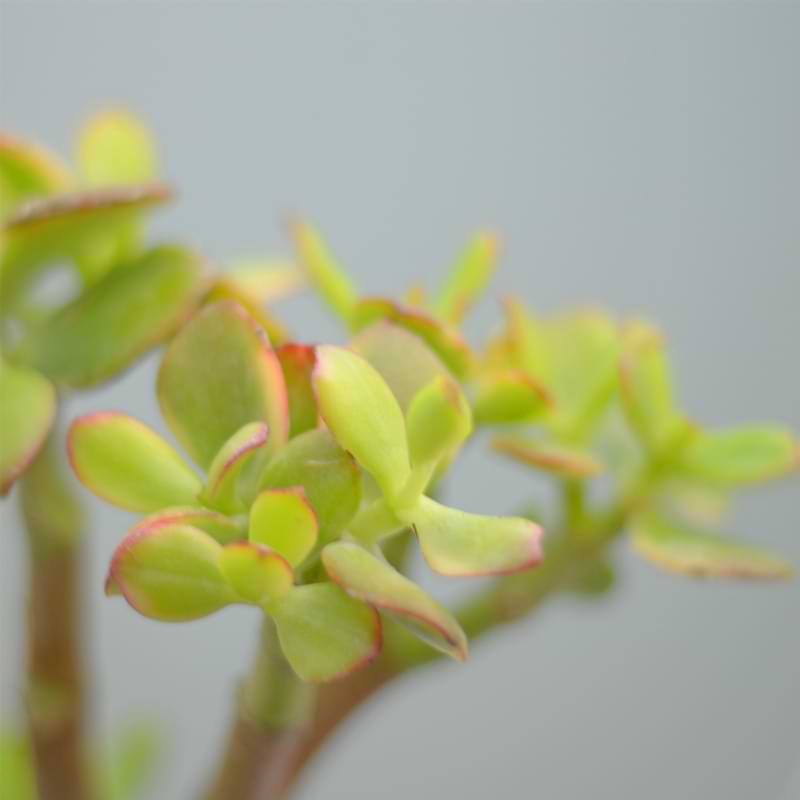The jade plant, known for its fleshy leaves and vibrant green color, is an excellent choice for bonsai enthusiasts who want to add a touch of sophistication to their collection. But mastering the art of jade bonsai requires knowledge, patience, and dedication. Don’t worry though, once you get the hang of it, Jade plants are really easy to care for!
How To Bonsai Jade Plants
Technically, any plant can be a bonsai plant. But there are some that are better suited to the bonsai style than others. Jade plants are great to bonsai, and it’s a fairly easy process, too!
Choosing a Suitable Jade Plant for Bonsai
If you’re looking at a Jade plant that is already one or two years old, you’ll need to make sure to choose a decent one for the bonsai process. First, assess the shape and size of the potential plant. It should have a thick trunk with well-developed branches that are still soft enough to be easily shaped into an aesthetically pleasing form.
You should also take note of the leaves’ color and texture. A healthy jade bonsai should exhibit bright green, plump leaves that are firm to touch. Finally, check for any signs of root rot, including leaves that seem droopy or soft.
Essential Tools and Materials for Bonsai
To create and maintain a beautiful Jade bonsai, gather some supplies that will help you keep your tree happy and healthy throughout its whole life.
- Pruning shears
- Wire cutters
- Bonsai training wire
- Bonsai soil mix
- Bonsai plant food
Pruning and Shaping Techniques for Jade Bonsai
When pruning your Jade bonsai, always use clean, sanitized, and sharp tools to avoid damaging the plant or transferring diseases to it from other plants. Trim branches at a 45-degree angle and make cuts just above a leaf node or bud. This will encourage new growth in that area.
Wiring and Positioning the Branches
Wiring and positioning the branches is the simplest way to shape your Jade bonsai into your desired style. Copper or aluminum wire ranging from 1mm-3mm in diameter works best for Jade bonsais, and is relatively easy to to maneuver around the branches.
Gently wrap the wire around the branch without causing damage to the plant, and without letting the wire cut into the delicate trunk or branches. Then, twist and bend it in a way that moves the branch in the direction you want while keeping its natural curve intact.
When wiring, make sure to avoid tight bends as they can cause scarring or even breakage of the branch. Additionally, be careful not to wrap too tightly around thin branches.
When it’s time to re-wire your tree, cut off the existing wire instead of trying to unwind it. This prevents possible breaking of the tree branches.
Displaying and Appreciating Your Jade Bonsai
Displaying your tree is the best part of owning a Jade bonsai. Everyone who visits your home will appreciate the beauty of the tree, so feel free to display it somewhere that everyone can see it. As long as it’s close to a source of natural light, it should be happy.

Nurturing Your Jade Bonsai Masterpiece
Regular care and nurturing of your Jade bonsai will keep it healthy for many years.
Temperature
Jade plants are native to warm climates, so they thrive in temperatures between 65°F and 75°F during the day and around 50°F at night. It’s important not to expose them to extreme temperature fluctuations, as this can send your plant into shock and could possibly permanently damage your tree.
Be careful of cold drafts in the winter and hot, direct sunlight in the summer. Both of these can cause damage to your tree. Do your best to maintain a relatively even temperature in your bonsai’s environment.
Lighting
Proper lighting is essential for the growth of your Jade bonsai. As a succulent, it requires bright but indirect sunlight to thrive. Direct sunlight can scorch its leaves and cause damage to the plant.
If you’re growing your Jade bonsai indoors, place it near a south-facing window that receives at least four hours of direct sunlight daily. You may also use artificial lighting, such as fluorescent or grow lights, if natural light is not sufficient.
Watering
Proper watering ensures that your plant stays healthy and thrives for years to come. How often you water your Jade bonsai depends on various factors, including the room’s temperature and humidity, the soil drainage, pot size, and the tree’s age.
Use a moisture meter before watering your plant each time, this will give you a better idea of how often you will need to water your plant, and will help you prevent root rot from taking your plant from you!
The easiest way to water your Jade bonsai is by filling a bowl or sink with a few inches of water and simply resting the Jade bonsai’s pot in the water, allowing it to drink up as much water as it needs through the drainage holes. Leave it there for at least 30 minutes, and then pull it out and allow any extra water to drain out before placing it back where it normally lives.

Fertilizing
Fertilizing your Jade bonsai ensures that the plant gets all the nutrients it needs to grow healthy and strong. It’s best to give your plant a smaller amount of nutrients more often than it is to give it a lot of nutrients at one time. You can accomplish this by using bonsai plant food instead of regular fertilizer. Either method will give your plant the nutrients it needs, but regular fertilizer does run the risk of fertilizer burn, which is detrimental to your plant.
Insects / Pests
Insects and pests can pose a serious threat to the health of your Jade bonsai. Pests to look out for are spider mites, mealybugs, fungus gnats, and scale. There are others, but these are the most common pests found in houseplants.
Spider mites suck sap from the leaves and cause them to dry out and turn brown, and leave a web on the underside of the plant’s leaves.
Scale are tiny white insects that feed off the sap from your plant and multiply very quickly.
Mealybugs leave behind a white, cottony residue on your plant’s leaves and stems, which can attract ants. To get rid of scale, spider mites, and mealybugs, use a cotton swab dipped in alcohol to wipe down each affected area.
Fungus gnats lay their eggs in moist soil and feed on organic matter in the potting mix. To prevent fungus gnats, allow the top layer of soil to dry out completely before watering again.
If you notice any signs of insect or pest infestation on your jade bonsai, act quickly to identify and treat the problem before it spreads further. Regularly inspecting your plant for unwanted visitors will help keep it healthy for years to come!
Repotting
Repotting helps refresh the soil and provide more space for the roots to grow. The best time to repot your Jade bonsai is during spring or summer when new growth emerges.
To repot your plant, all you need is a new pot and new soil. You may also want pruning shears to prune off any dead or diseased roots while you have it out of the pot.
Gently remove it from its current pot while being careful not to damage any of the branches or leaves. Trim away any dead or excessively long roots with clean scissors or shears before placing it in its new container with fresh soil mix. Don’t compact the roots during this step, you’ll want to gradually let the plant rest in the pot while adding soil around the different layers of roots, making the plant stable and the roots able to breathe.
Propagating
There are different methods of propagating your Jade bonsai, including stem cuttings and leaf cuttings. Before propagating your plant, make sure that the parent plant is healthy and has no diseases or pests.
To propagate by stem cuttings, cut a 2-3 inch section of the stem with at least two leaves using sharp pruning shears. Remove the lower leaves and dip the cutting in rooting hormone before planting it in well-draining soil. From here, keep the soil moist and you should see growth above the soil in a couple of months.
Leaf cuttings involve removing individual leaves from the parent plant and laying them flat on top of moist soil. The leaf should be placed right-side up with its base inserted slightly into the soil. Over time, roots will develop from the base of each leaf, forming new plants. This method does take quite a bit longer, but since there are more leaves on a plant than there are stems, you can get more Jade plants from this method.
Regardless of which method you choose, keep your propagated Jade bonsai in a warm place out of direct sunlight until it establishes itself in its new potting mix.
FAQ Jade Bonsai
How long does a jade bonsai take to grow?
Jade bonsai trees are known for their slow growth rate, but you can make the most of their growth rate by ensuring the plant gets enough light, water, and nutrients, and that any possible problems are taken care of quickly.
Even with all the right steps followed, it can take anywhere from three to ten years or more for a jade plant to develop into a mature and beautiful bonsai tree.
What is the lifespan of a jade plant?
Well-maintained jade plants have been known to live for several decades! So with proper care and love from their owners (that’s you!), these charming little trees may just be around long enough for future generations to enjoy too.
Join The Bonsai World
At The Bonsai Resource Center, our goal is to equip you with everything you need to grow and maintain a truly beautiful bonsai tree. This is our passion, and we want it to be yours as well! Whether you are a bonsai beginner or are looking to hone your skills, check out our other articles and visit our shop for all your bonsai needs!



